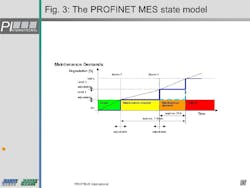PROFINET Provides Vertical Integration
Integration of automation systems into Manufacturing Execution Systems (MES) and Enterprise Resource Planning (ERP) is becoming an increasingly important feature of corporate-wide information technology strategies. As companies strive to achieve greater flexibility, enhance delivery performance, and improve quality, they have continued to push the integration of IT and production systems.
MES systems are positioned between ERP systems and production automation and control systems. Ethernet-based PROFINET offers an excellent mechanism for capturing process data as well as information that is relevant in the MES context. PROFINET, an open, manufacturer-independent Industrial Ethernet standard for the manufacturing and process industries, uses TCP/IP and IT standards to provide seamless communication from the corporate management level right down to field devices. It offers scalable real-time communications up to synchronized motion control.
The major specification for MES solutions is the Instrumentation, Systems and Automation Society’s ISA S95, which defines interaction models and uniform terminology. The specification, which has largely been incorporated into international standard ISO/IEC 62264, divides MES into four categories:
- Production
- Quality
- Maintenance
- Inventory
It has been difficult in the past to transfer information from automation systems to the MES because there were no established standards. PI (PROFIBUS & PROFINET International) has published the PROFINET and MES Maintenance Operations guideline to address this problem. It describes PROFINET functionality which is not directly relevant at the automation level but which is very important for MES maintenance systems.
Condition monitoring at the control system level
The status of a production asset is an essential piece of information that can be used to assess system availability, and this makes it a key parameter in the production planning process. The MES Maintenance Operations activity model needs status information as an input for planning and execution of maintenance activities.
Status information can normally only be provided by system components which have communications capability. These components can also act as proxies for components that do not have this capability. The availability of a standardized communications mechanism is extremely important to avoid extensive engineering work.
PROFINET uses an expanded “traffic light” model to represent device states. The warning levels maintenance request and maintenance demand have been added to supplement the device fault status. An additional 30 status conditions per device can be defined, and this ensures that maintenance state data (standardized device status information from the control system level) is adequate to handle future requirements.
The two warning levels can be used to distinguish between a condition that requires attention without delay and a condition that can be addressed during scheduled preventive maintenance. They support simple implementation of condition-based maintenance wherever wear, contamination, etc. can impair equipment operation. Manufacturers can define monitored entities that are associated with device channels and are used to track device status. A channel can have one or more monitored entities. A message is sent to the I/O controller whenever the state of a monitored entity changes using the diagnostic alarms defined in the PROFINET specification. This ensures that no information is lost and guarantees maximum transparency. Reporting the state change as an event avoids an increase in the communications load, and the status data can be accessed in acyclic mode. (See Figure.)
There is common definition of the maintenance state for PROFINET I/O nodes and Component Based Automation (CBA) components. The status information for CBA components is stored in the component interface for the monitored entities and as a summary status for all of the components using the same syntax and semantics. The component manufacturer supplies the information to the interface.
Electronic device identification
Other PROFINET functionality important in the MES context includes the ability to electronically and uniquely identify the devices that are installed on the system. PROFINET uses the functions that are defined in the Identification and Maintenance Functions (I&M) guideline.
The basic I&M functions include the electronic nameplate which the manufacturer stores in the device and which can be read by the user. The nameplate contains device-specific data relating to items such as spare part selection, procurement and inventory, and it can also be used to schedule device updates. Some of the information contained in the electronic nameplate is as follows:
- Device manufacturer
- Order number
- Hardware revision
- Firmware revision
- Revision number
In addition to the electronic nameplate, other I&M data has been defined—such as system and location ID and installation date and comments—that users can store in the device when they are installing the system.
PROFINET is a powerful communications technology that provides excellent support for MES and ERP systems. The PROFINET and MES Maintenance Operations guideline lays the foundation for future convergence of MES and automation systems.
For more information, please visit Profibus.

